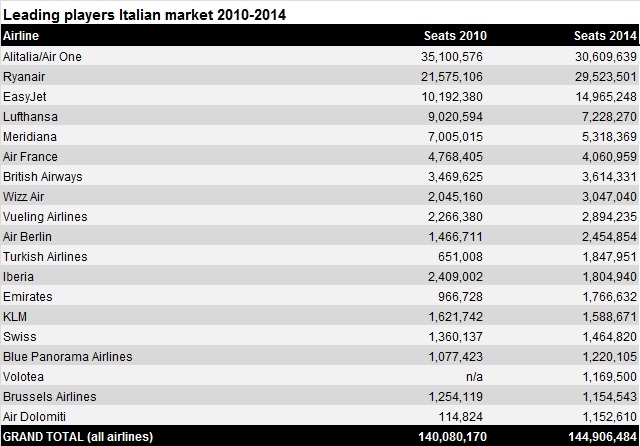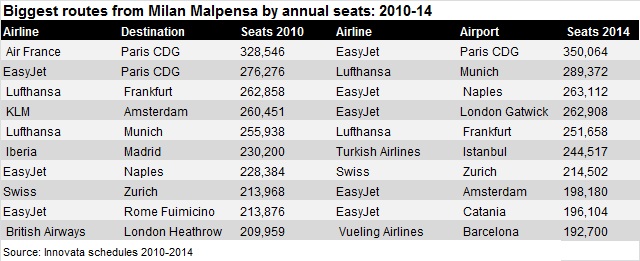Few markets in Europe have been as fragmented and have seen non-home-market carriers make such inroads as Italy has.
The sustained weakness of Italian national carrier Alitalia had already created a widely fragmented market, one in which local rivals were able to develop and pan-European low-cost carriers made their mark.
That local Italian competition then faded as consolidation – notably the rolling of Italy's second biggest carrier Air One into Alitalia as part of the latter's move into private ownership in 2009 – and airline collapses took a toll. In the meantime, the low-cost carriers continued to stake their claim across Italy.
Innovata schedules data shows the extent to which low-cost carriers have taken Italian market share from their network rivals. Annual seats in the Italian market for 2014 have changed relatively little from 2010 levels at nearly 145 million compared with 140 million. But while in 2010 low-cost carriers accounted for 56 million of these seats, the figure has grown to 65 million this year. Network carriers meanwhile offered five million fewer seats at just under 80 million.

The gap is even closer on short and medium-haul routes only. On Italian routes of five hours or below, low-cost carriers hold a 48.5% share. This compares with 43% in 2010.
Budget carrier Ryanair is the most obvious mover over this period. It has added another eight million seats in the Italian market over the five-year period and now has just under 30 million seats in the market, Innovata data shows. Alitalia, when combined with its Air One unit, has around one million more seats in the market. But this is 4.5 million fewer than in 2010, when the newly combined Alitalia-Air One was by some distance the biggest operator in Italy.

Passenger traffic data released by ENAC recently also show relatively little between the two carriers: Alitalia and its related group operators carrying just under 24 million passengers in 2013, just under a million more than Ryanair.
The Irish carrier is adding further pressure to Alitalia by adding a new base at Rome Fiumicino – focusing on domestic routes – leaving its Rome Ciampino operation to focus on international expansion. Spanish low-cost carrier Vueling is also launching a base from Fiumicino this summer. Another low-cost carrier EasyJet has been established at the Roman airport for some time.
Fiuminco is one of 14 bases Ryanair now has in Italy, many of them based in southern Italy – notably in Sardinia and Sicily,
While EasyJet's recently opened third base in country is in the heart of southern Italy in Naples, much of the driver of its growth – whereby it has lifted capacity in annual seats 50% over the last five years – has come from its strength further north at Rome Fiumicino and, in particular, Milan Malpensa. The Lombardy region airport is its second-biggest base across its overall network and it now has 18 aircraft at Malpensa.
A look at the development of Malpensa's 10 biggest routes of less than four hours by seats shows the extent to which EasyJet has become a key player at the Milan airport. In 2010 EasyJet operated three of the 10 biggest routes, but by this year it is operating five of them, including three of the four biggest.

That includes the biggest – the Malpensa-Paris Charles de Gaulle connection route – which was the number one and two service in 2010 but offered by both Air France and EasyJet. Air France has since dropped its Malpensa link and consolidated its operation at Milan's downtown airport Linate, from where its partner Alitalia also serves Charles de Gaulle.
EasyJet itself made a landmark entry into Linate last year after ending the Alitalia/Air One monopoly on landmark Italian domestic route, Linate-Fiumicino. "It has been very good for us. It's been iconic because it broke a monopoly that was there for 40 years, and I think it's been really important from a business traveller perspective: it's really increased our saliency in the business community," says EasyJet chief executive Carolyn McCall. "It was never going to be an easy route, because you've got Alitalia on it extensively and you've got the high-speed train... but that doesn't mean we won't continue doing it."
The key Rome-Milan business route may have been surpassed as the biggest Italian route by the north-south connection of Rome Fiumicino-Catania, but traffic for 2013 from Italian civil aviation authority ENAC shows it remains one of the country's biggest routes.

Spanish carrier Vueling has detailed its plans to launch four daily flights linking Rome Fiumicino with Catania from May, which marks the latest change of dynamic on Italy's busiest domestic route until recently served only by Italian carriers Alitalia, Meridiana and Blue Panorama. That ended in December when Ryanair switched its Catania link from Ciampino to Fiumicino as part its move to a two-airport strategy at Rome.
Catania-Rome Fiumicino share capacity June 2014

Source: Innovata schedules for June 2014
If low-cost carriers have made some inroads on Italy's biggest domestic links, the busiest Italian links on European international routes by passenger numbers in 2013 still have the ring of network operators about them. The biggest route in 2013 was the Air France and Alitalia stronghold of Rome Fiumicino-Paris Charles de Gaulle – EasyJet serves the Roman airport from its Paris Orly base instead.

Of the five biggest routes by passenger numbers in 2013 according to ENAC figures, only the Rome Fiumicino-Amsterdam Schiphol link is one where a low-cost carrier – EasyJet – has a significant presence on the route.
Low-cost sector operators from elsewhere in Europe have also been expanding in Italy. Wizz Air has added a million seats over the last five years, Vueling 400,000 and Volotea – which started operations in 2012 and has bases in Palermo and Venice – is already offering over a million seats on its Italian routes.
Similarly fast-growing carriers are making their mark in the Italian market. Emirates has doubled its capacity over the last five years and Turkish Airlines has trebled its seats in the market over the same period.
Meridiana is the second-largest Italian carrier by total seats offered in 2014 – though only the fifth largest in total. Following the demise of Windjet, only two other Italian carriers figure among the leading operators – Blue Panorama and Air Dolomiti, and the latter is 100% owned by Lufthansa.
Source: Cirium Dashboard



















